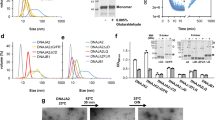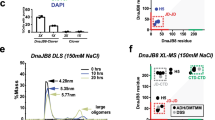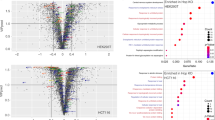Abstract
LKB1 is a tumor suppressor that is constitutionally mutated in a cancer-prone condition, called Peutz-Jeghers syndrome, as well as somatically inactivated in a sizeable fraction of lung and cervical neoplasms. The LKB1 gene encodes a serine/threonine kinase that associates with the pseudokinase STRAD (STE-20-related pseudokinase) and the scaffolding protein MO25, the formation of this heterotrimeric complex promotes allosteric activation of LKB1. We have previously reported that the molecular chaperone heat shock protein 90 (Hsp90) binds to and stabilizes LKB1. Combining pharmacological studies and RNA interference approaches, we now provide evidence that the co-chaperone Cdc37 participates to the regulation of LKB1 stability. It is known that the Hsp90–Cdc37 complex recognizes a surface within the N-terminal catalytic lobe of client protein kinases. In agreement with this finding, we found that the chaperones Hsp90 and Cdc37 interact with an LKB1 isoform that differs in the C-terminal region, but not with a novel LKB1 variant that lacks a portion of the kinase N-terminal lobe domain. Reconstitution of the two complexes LKB1–STRAD and LKB1–Hsp90–Cdc37 with recombinant proteins revealed that the former is catalytically active whereas the latter is inactive. Furthermore, consistent with a documented repressor function of Hsp90, LKB1 kinase activity was transiently stimulated upon dissociation of Hsp90. Finally, disruption of the LKB1–Hsp90 complex favors the recruitment of both Hsp/Hsc70 and the U-box dependent E3 ubiquitin ligase CHIP (carboxyl terminus of Hsc70-interacting protein) that triggers LKB1 degradation. Taken together, our results establish that the Hsp90–Cdc37 complex controls both the stability and activity of the LKB1 kinase. This study further shows that two chaperone complexes with antagonizing activities, Hsp90–Cdc37 and Hsp/Hsc70–CHIP, finely control the cellular level of LKB1 protein.
This is a preview of subscription content, access via your institution
Access options
Subscribe to this journal
Receive 50 print issues and online access
$259.00 per year
only $5.18 per issue
Buy this article
- Purchase on Springer Link
- Instant access to full article PDF
Prices may be subject to local taxes which are calculated during checkout







Similar content being viewed by others
References
Alessi DR, Sakamoto K, Bayascas JR . (2006). LKB1-dependent signaling pathways. Annu Rev Biochem 75: 137–163. Review.
Baas AF, Boudeau J, Sapkota GP, Smit L, Medema R, Morrice NA et al. (2003). Activation of the tumour suppressor kinase LKB1 by the STE20-like pseudokinase STRAD. EMBO J 22: 3062–3072.
Baas AF, Kuipers J, van der Wel NN, Batlle E, Koerten HK, Peters PJ et al. (2004). Complete polarization of single intestinal epithelial cells upon activation of LKB1 by STRAD. Cell 116: 457–466.
Ballinger CA, Connell P, Wu Y, Thompson LJ, Yin LY, Patterson C . (1999). Identification of CHIP, a novel tetratricopeptide repeat-containing protein that interacts with heat shock proteins and negatively regulates chaperone functions. Mol Cell Biol 19: 4535–4545.
Beers M, Kemphues K . (2006). Depletion of the co-chaperone CDC-37 reveals two modes of PAR-6 cortical association in C. elegans embryos. Development 133: 3745–3754.
Boudeau J, Baas AF, Deak M, Morrice NA, Kieloch A, Schutkowski M et al. (2003b). MO25alpha/beta interact with STRADalpha/beta enhancing their ability to bind, activate and localize LKB1 in the cytoplasm. EMBO J 22: 5102–5114.
Boudeau J, Deak M, Lawlor MA, Morrice NA, Alessi DR . (2003a). Heat-shock protein 90 and Cdc37 interact with LKB1 and regulate its stability. Biochem J 370: 849–857.
Brajenovic M, Joberty G, Küster B, Bouwmeester T, Drewes G . (2004). Comprehensive proteomic analysis of human Par protein complexes reveals an interconnected protein network. J Biol Chem 279: 12804–12811.
Caplan AJ, Mandal AK, Theodoraki MA . (2007). Molecular chaperones and protein kinase quality control. Trends Cell Biol 17: 87–92. Review.
Citri A, Harari D, Shohat G, Ramakrishnan P, Gan J, Lavi S et al. (2006). Hsp90 recognizes a common surface on client kinases. J Biol Chem 281: 14361–14369.
Connell P, Ballinger CA, Jiang J, Wu Y, Thompson LJ, Höhfeld J et al. (2001). The co-chaperone CHIP regulates protein triage decisions mediated by heat-shock proteins. Nat Cell Biol 3: 93–96.
Corradetti MN, Inoki K, Bardeesy N, DePinho RA, Guan KL . (2004). Regulation of the TSC pathway by LKB1: evidence of a molecular link between tuberous sclerosis complex and Peutz-Jeghers syndrome. Genes Dev 18: 1533–1538.
Cyr DM, Höhfeld J, Patterson C . (2002). Protein quality control: U-box-containing E3 ubiquitin ligases join the fold. Trends Biochem Sci 27: 368–375.
Demand J, Alberti S, Patterson C, Höhfeld J . (2001). Cooperation of a ubiquitin domain protein and an E3 ubiquitin ligase during chaperone/proteasome coupling. Curr Biol 11: 1569–1577.
Denison FC, Hiscock NJ, Carling D, Woods A . (2009). Characterization of an alternative splice variant of LKB1. J Biol Chem 284: 67–76.
Donzé O, Abbas-Terki T, Picard D . (2001). The Hsp90 chaperone complex is both a facilitator and a repressor of the dsRNA-dependent kinase PKR. EMBO J 20: 3771–3780.
Ehrlich ES, Wang T, Luo K, Xiao Z, Niewiadomska AM, Martinez T et al. (2009). Regulation of Hsp90 client proteins by a Cullin5-RING E3 ubiquitin ligase. Proc Natl Acad Sci USA 106: 20330–20335.
Fan M, Park A, Nephew KP . (2005). CHIP (carboxyl terminus of Hsc70-interacting protein) promotes basal and geldanamycin-induced degradation of estrogen receptor-alpha. Mol Endocrinol 19: 2901–2914.
Hardie DG . (2008). Role of AMP-activated protein kinase in the metabolic syndrome and in heart disease. FEBS Lett 582: 81–89. Review.
Hawley SA, Boudeau J, Reid JL, Mustard KJ, Udd L, Mäkelä TP et al. (2003). Complexes between the LKB1 tumor suppressor, STRAD alpha/beta and MO25 alpha/beta are upstream kinases in the AMP-activated protein kinase cascade. J Biol 2: 28.
Hemminki A, Markie D, Tomlinson I, Avizienyte E, Roth S, Loukola A et al. (1998). A serine/threonine kinase gene defective in Peutz-Jeghers syndrome. Nature 391: 184–187.
Hezel AF, Bardeesy N . (2008). LKB1; linking cell structure and tumor suppression. Oncogene 27: 6908–6919. Review.
Hieronymus H, Lamb J, Ross KN, Peng XP, Clement C, Rodina A et al. (2006). Gene expression signature-based chemical genomic prediction identifies a novel class of Hsp90 pathway modulators. Cancer Cell 10: 321–330.
Jansen M, Ten Klooster JP, Offerhaus GJ, Clevers H . (2009). LKB1 and AMPK family signaling: the intimate link between cell polarity and energy metabolism. Physiol Rev 89: 777–798. Review.
Jenne DE, Reimann H, Nezu J, Friedel W, Loff S, Jeschke R et al. (1998). Peutz-Jeghers syndrome is caused by mutations in a novel serine threonine kinase. Nat Genet 18: 38–43.
Koga F, Xu W, Karpova TS, McNally JG, Baron R, Neckers L . (2006). Hsp90 inhibition transiently activates Src kinase and promotes Src-dependent Akt and Erk activation. Proc Natl Acad Sci U S A 103: 11318–11322.
Lee JH, Koh H, Kim M, Kim Y, Lee SY, Karess RE et al. (2007). Energy-dependent regulation of cell structure by AMP-activated protein kinase. Nature 447: 1017–1020.
Lizcano JM, Goransson O, Toth R, Deak M, Morrice NA, Boudeau J et al. (2004). LKB1 is a master kinase that activates 13 kinases of the AMPK subfamily, including MARK/PAR-1. EMBO J 23: 833–843.
McDonough H, Patterson C . (2003). CHIP: a link between the chaperone and proteasome systems. Cell Stress Chaperones 8: 303–308. Review.
Meacham GC, Patterson C, Zhang W, Younger JM, Cyr DM . (2001). The Hsc70 co-chaperone CHIP targets immature CFTR for proteasomal degradation. Nat Cell Biol 3: 100–105.
Murata S, Chiba T, Tanaka K . (2003). CHIP: a quality-control E3 ligase collaborating with molecular chaperones. Int J Biochem Cell Biol 35: 572–578. Review.
Nony P, Gaude H, Rossel M, Fournier L, Rouault JP, Billaud M . (2003). Stability of the Peutz-Jeghers syndrome kinase LKB1 requires its binding to the molecular chaperones Hsp90/Cdc37. Oncogene 22: 9165–9175.
Shaw RJ, Bardeesy N, Manning BD, Lopez L, Kosmatka M, DePinho RA et al. (2004). The LKB1 tumor suppressor negatively regulates mTOR signaling. Cancer Cell 6: 91–99.
Sreeramulu S, Gande SL, Göbel M, Schwalbe H . (2009). Molecular mechanism of inhibition of the human protein complex Hsp90-Cdc37, a kinome chaperone-cochaperone, by triterpene celastrol. Angew Chem Int Ed Engl 48: 5853–5855.
Stancato LF, Silverstein AM, Owens-Grillo JK, Chow YH, Jove R, Pratt WB . (1997). The hsp90-binding antibiotic geldanamycin decreases Raf levels and epidermal growth factor signaling without disrupting formation of signaling complexes or reducing the specific enzymatic activity of Raf kinase. J Biol Chem 272: 4013–4020.
Stepanova L, Leng X, Parker SB, Harper JW . (1996). Mammalian p50Cdc37 is a protein kinase-targeting subunit of Hsp90 that binds and stabilizes Cdk4. Genes Dev 10: 1491–1502.
Towler MC, Fogarty S, Hawley SA, Pan DA, Martin DM, Morrice NA et al. (2008). A novel short splice variant of the tumour suppressor LKB1 is required for spermiogenesis. Biochem J 416: 1–14.
Vaughan CK, Mollapour M, Smith JR, Truman A, Hu B, Good VM et al. (2008). Hsp90-dependent activation of protein kinases is regulated by chaperone-targeted dephosphorylation of Cdc37. Mol Cell 31: 886–895.
Whitesell L, Lindquist SL . (2005). Hsp90 and the chaperoning of cancer. Nat Rev Cancer 5: 761–772. Review.
Woods A, Johnstone SR, Dickerson K, Leiper FC, Fryer LG, Neumann D et al. (2003). LKB1 is the upstream kinase in the AMP-activated protein kinase cascade. Curr Biol 13: 2004–2008.
Xu W, Marcu M, Yuan X, Mimnaugh E, Patterson C, Neckers L . (2002). Chaperone-dependent E3 ubiquitin ligase CHIP mediates a degradative pathway for c-ErbB2/Neu. Proc Natl Acad Sci USA 99: 12847–12852.
Xu W, Yuan X, Beebe K, Xiang Z, Neckers L . (2007). Loss of Hsp90 association up-regulates Src-dependent ErbB2 activity. Mol Cell Biol 27: 220–228.
Xu W, Yuan X, Xiang Z, Mimnaugh E, Marcu M, Neckers L . (2005). Surface charge and hydrophobicity determine ErbB2 binding to the Hsp90 chaperone complex. Nat Struct Mol Biol 12: 120–126.
Yano A, Tsutsumi S, Soga S, Lee MJ, Trepel J, Osada H et al. (2008). Inhibition of Hsp90 activates osteoclast c-Src signaling and promotes growth of prostate carcinoma cells in bone. Proc Natl Acad Sci U S A 105: 15541–15546.
Zeqiraj E, Filippi BM, Deak M, Alessi DR, van Aalten DM . (2009). Structure of the LKB1-STRAD-MO25 complex reveals an allosteric mechanism of kinase activation. Science 326: 1707–1711.
Zhang T, Li Y, Yu Y, Zou P, Jiang Y, Sun D . (2009). Characterization of celastrol to inhibit Hsp90 and Cdc37 interaction. J Biol Chem 284: 35381–35389.
Acknowledgements
We thank Len Neckers and Dirk Bohmann for the kind gifts of the CHIP and HA-ubiquitin vectors, respectively. This work was supported by the Ligue Nationale Contre le Cancer, and Association de Recherche sur le Cancer. During this work HG, NA and CC have been the recipients of fellowship from the Ligue Nationale Contre le Cancer, Ligue Nationale Contre le Cancer, Comité de l’Isère, Association de Recherche sur le Cancer and Fondation pour la Recherche Médicale and CNRS, respectively.
Author information
Authors and Affiliations
Corresponding authors
Ethics declarations
Competing interests
The authors declare no conflict of interest.
Additional information
Supplementary Information accompanies the paper on the Oncogene website
Supplementary information
Rights and permissions
About this article
Cite this article
Gaude, H., Aznar, N., Delay, A. et al. Molecular chaperone complexes with antagonizing activities regulate stability and activity of the tumor suppressor LKB1. Oncogene 31, 1582–1591 (2012). https://doi.org/10.1038/onc.2011.342
Received:
Revised:
Accepted:
Published:
Issue Date:
DOI: https://doi.org/10.1038/onc.2011.342
Keywords
This article is cited by
-
RBM4 dictates ESCC cell fate switch from cellular senescence to glutamine-addiction survival through inhibiting LKB1-AMPK-axis
Signal Transduction and Targeted Therapy (2023)
-
Multifaceted C-terminus of HSP70-interacting protein regulates tumorigenesis via protein quality control
Archives of Pharmacal Research (2019)
-
Controlling the master—upstream regulation of the tumor suppressor LKB1
Oncogene (2018)
-
Post-translational regulation contributes to the loss of LKB1 expression through SIRT1 deacetylase in osteosarcomas
British Journal of Cancer (2017)
-
CHIP−/−-Mouse Liver: Adiponectin-AMPK-FOXO-Activation Overrides CYP2E1-Elicited JNK1-Activation, Delaying Onset of NASH: Therapeutic Implications
Scientific Reports (2016)



